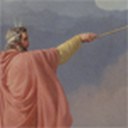0119 Nathanson, Eckersberg's Moses, and Danish Haskalah ('Reformed Judaism')
Identifiers (Article)
Identifiers (Files)
Abstract
Among the patrons of the young C. W. Eckersberg (1783-1853), the Jewish merchant M. L. Nathanson (1780-1868) was the most important. A key figure in the process eventually leading to the Danish Jews obtaining complete legal and civic parity (1849), Nathanson can be shown to have pioneered art patronage as a platform for social and cultural integration. His commissions for patriotic "Galleries" (imitating Boydell's British Shakespeare Gallery) and for family portraits illustrate his efforts to give art a new role in this process. Hitherto ignored, so does his commission for a monumental Moses Crossing the Red Sea – a work that in its iconography, as developed by Eckersberg between 1812 and 1817, represents a remarkable fusion of Jewish, Greco-Roman and Christian elements that combined with overt loans from Raphael and Giovanni Donducci gives it a unique place in Eckersberg's oeuvre.
Statistics

License

This work is licensed under a Creative Commons Attribution-NonCommercial-NoDerivatives 4.0 International License.




